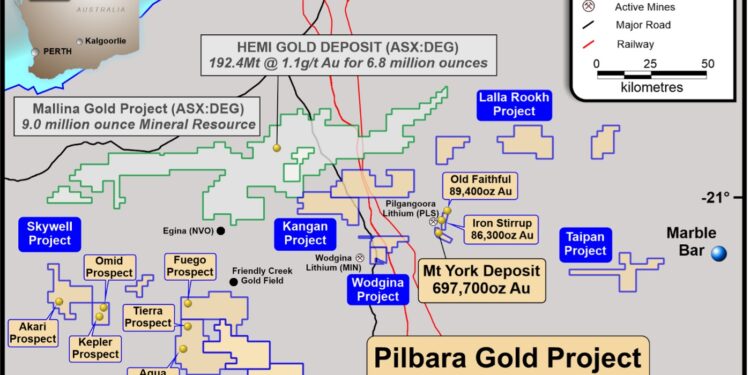Kairos Minerals Ltd (ASX: KAI) has confirmed the presence of an extensive swarm of pegmatites within the previously identified Lithium-Caesium-Tantalum (LCT) target at its 100%-owned Wodgina Project, located 90km south of Port Hedland in Western Australia’s Pilbara Region.
This high priority LCT target is located less than three km from the Wodgina Lithium Mine, owned by Mineral Resources and Albemarle Corporation.
The company has now received all of the remaining results from the successful geochemical sampling programme conducted at the Wodgina Project. The complete data analysis has confirmed the previously announced LCT targets.
A total of 1,517 soil samples were collected at 200m x 100m spacing and submitted for Ultrafine+™ analysis at the Labwest Laboratory in Perth. Kairos has also now completed the in-fill air-core (AC) drilling program at its 100%-owned Kangan Project.
Drilling contractor Bostech drilled a total of 56 holes for 2,056m. The in-fill AC programme was designed to follow up the anomalous results for gold and lithium returned from the first-phase drilling programme.
Ground-truth work – Wodgina Project
Preliminary results from the Ultrafine+ geochemistry program at the Wodgina Project identified a ~1.7km long target area defined by coherent and robust LCT anomalies, with values of up to 238ppm Li, 293ppm Cs, 582ppm Rb and 78ppb Ta returned from Ultrafine+™ soil analysis with coincident elevated arsenic, indium, thallium and tungsten.
Kairos’ Executive Chairman, Terry Topping, said samples from this target area returned the highest lithium, caesium, rubidium, and thallium values.
“In terms of lithium exploration, you don’t get a much better address than our Wodgina Project, which sits between the world-class Wodgina Lithium Mine, owned by Mineral Resources, and the Pilgangoora Project, owned by Pilbara Minerals,” Mr Topping said.
“These are two of only a handful of genuinely Tier-1 hard rock lithium deposits in Australia, indeed the world – so this is elephant country in terms of its potential for world-class spodumene deposits. “It is in this context that our early-stage exploration results should be seen.
“We have now been able to build on the success of our Ultrafine+ soil sampling programme, which defined a large LCT anomaly, by confirming the presence of extensive outcropping pegmatite swarms. This is an important development, albeit that we need to wait for assays from the samples we have collected within the LCT soil anomaly area to confirm that they are lithium-bearing.
“The recently completed high-resolution drone survey has confirmed the scale and potential of this pegmatite swarm, and has further elevated the importance of this Project as an important focus for our exploration activities in the Pilbara next year. We are eagerly awaiting the assays from the rock chip samples, which should be available by late January or early February.
“Subject to those results, we will be seeking to progress the heritage approvals process and obtain clearances for drilling as soon as we can in the New Year – and getting some holes into this exciting target at the start of our 2022 field season!”
Kairos’ geologists conducted a field trip to investigate the target area. The first pass mapping and rock chip sampling programme has confirmed the presence of pegmatite outcrops near the lithium indicator geochemistry. A total of 15 pegmatite rock chip samples were collected, and a high-resolution drone survey was completed over the area.
The samples were submitted to Intertek Laboratory in Perth for four-acid multielement analysis. Assay results are expected in late-January or early-February.
For further information please visit: https://www.kairosminerals.com.au/












